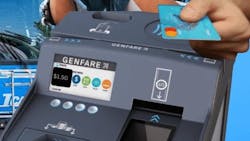TCAT and Genfare introduce tap to pay fare collection, daily fare capping
Tompkins Consolidated Area Transit, Inc. (TCAT) has launched tap to pay services on its fareboxes, allowing customers to pay fares with a contactless credit or debit card or mobile wallet.
TCAT’s fareboxes now also support daily fare capping, allowing riders to take unlimited rides during the same service day after paying for two rides with the same bankcard, digital wallet, rechargeable Tcard or Tfare app.
TCAT says the new system streamlines payments, allowing for quicker fare payment at fareboxes while also removing barriers for tourists, new users of the system or riders that couldn’t pre-purchase a pass.
Ongoing farebox modernization
In partnership with Genfare, the new open payment features mark the next steps in the process for TCAT in upgrading its 14-year-old fare collection system. Since last year, passengers have been able to use smartcards and mobile apps to pay for fares.
“We are proud that we can finally take this next step by implementing a more rider-friendly, tap-and-go technology that our customers want and deserve,” said TCAT General Manager Matthew Rosenbloom-Jones. “Open payment and fare capping have been around for well over a decade with larger transit systems obviously being the first adopters. In recent years, farebox manufacturers have been expanding into smaller markets enabling more agencies, like ours, to offer the technology as funding becomes available.”
Rosenbloom-Jones went on to say, “It is essential for us to use our resources for new buses and for our other immediate needs, but it is also important to simplify the farebox, which can be the most challenging part of riding a bus, especially for newcomers.”
While riders can tap their preferred payment method, reduced fare recipients must inform the operator before using the new tap to pay feature to receive their reduced fare.
TCAT’s fare capping still in its early stages
Currently, fare capping is restricted to just single service days with the $3 cap. Riders receiving reduced fares will also be capped at $3, meaning they’ll have to pay for four rides before taking the rest of their rides for free.
The agency hopes to expand fare capping to a monthly basis, allowing riders to pay per ride while enjoying the benefit of a $45 unlimited monthly pass without having to bear the entire cost upfront. Once a rider logs 30 single trips on their smartcard or app, their preferred payment method automatically offers unlimited rides at no charge for the remainder of the month.
“The transit industry has long recognized that it’s only fair that someone on a tight budget or living paycheck to paycheck enjoys the same discount for unlimited rides as someone who has more discretionary income,” Rosenbloom-Jones said. “We are pleased that we can finally start offering a more equitable approach to fare collection.”
